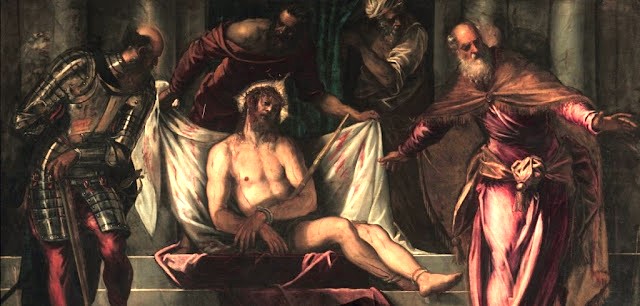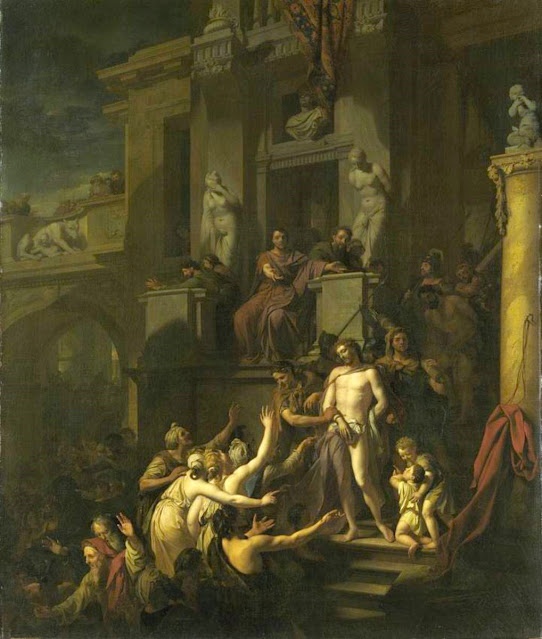“Peter, filled with the Holy Spirit, said:
"Leaders of the people and elders:
If we are being examined today
about a good deed done to a cripple,
namely, by what means he was saved,
then all of you and all the people of Israel should know
that it was in the name of Jesus Christ the Nazorean
whom you crucified, whom God raised from the dead;
in his name this man stands before you healed.
He is the stone rejected by you, the builders,
which has become the cornerstone.
There is no salvation through anyone else,
nor is there any other name under heaven
given to the human race by which we are to be saved."
(Acts 4:8-12) First Reading for the Fourth Sunday of Easter Year B)1
Since the liturgical reforms of Vatican Council II, the Catholic Church follows a three-year cycle (Years A, B and C) of readings on Sundays (and a two year cycle on weekdays). This means that, with a very few exceptions, the readings for a given Sunday rotate from year to year. However, there is sometimes a relationship between readings over the three-year cycle. The Fourth Sunday of Easter, which occurs this year on April 29th, is a case in point. It is known as “Good Shepherd Sunday” and, in each phase of the cycle, features a Gospel reading that is drawn from different portions of Chapter 10 of the Gospel of John. This year (2012) the passage is the actual “I am the Good Shepherd” portion (John 10:11-18).
During the Easter Season, also, the first of the three weekly readings is drawn from the Acts of the Apostles. But, unlike the Gospel reading for the Fourth Sunday of Easter, the first reading varies by year within the cycle. In Year B (2012) the reading for this Fourth Sunday is a continuation of the readings from Acts that have been read at the daily Masses during the past few weeks. Acts Chapters 3, 4 and 5 focus on a series of events in the life of Saint Peter and the other apostles at the very beginning of the Church.
 |
| Masaccio, Saint Peter Healing With His Shadow Italian, c. 1426-1427 Florence, Santa Maria del Carmine, Brancacci Chapel |
"Leaders of the people and elders:
If we are being examined today
about a good deed done to a cripple,
namely, by what means he was saved,
then all of you and all the people of Israel should know
that it was in the name of Jesus Christ the Nazorean
whom you crucified, whom God raised from the dead;
in his name this man stands before you healed.
He is the stone rejected by you, the builders,
which has become the cornerstone.
There is no salvation through anyone else,
nor is there any other name under heaven
given to the human race by which we are to be saved."
(Acts 4:8-12) First Reading for the Fourth Sunday of Easter Year B)1
Since the liturgical reforms of Vatican Council II, the Catholic Church follows a three-year cycle (Years A, B and C) of readings on Sundays (and a two year cycle on weekdays). This means that, with a very few exceptions, the readings for a given Sunday rotate from year to year. However, there is sometimes a relationship between readings over the three-year cycle. The Fourth Sunday of Easter, which occurs this year on April 29th, is a case in point. It is known as “Good Shepherd Sunday” and, in each phase of the cycle, features a Gospel reading that is drawn from different portions of Chapter 10 of the Gospel of John. This year (2012) the passage is the actual “I am the Good Shepherd” portion (John 10:11-18).
During the Easter Season, also, the first of the three weekly readings is drawn from the Acts of the Apostles. But, unlike the Gospel reading for the Fourth Sunday of Easter, the first reading varies by year within the cycle. In Year B (2012) the reading for this Fourth Sunday is a continuation of the readings from Acts that have been read at the daily Masses during the past few weeks. Acts Chapters 3, 4 and 5 focus on a series of events in the life of Saint Peter and the other apostles at the very beginning of the Church.
 |
| Masaccio, View of the Brancacci Chapel |
During the years 1425-1427 these events from the life of Saint Peter formed the basis for one of the seminal artistic projects that mark the beginning of the transition of Italian Renaissance art from the still medieval Quattrocento toward the pinnacle of the High Renaissance.
This project was the decoration of a chapel, financed by the Brancacci family, in the church of Santa Maria del Carmine in Florence by two artists with the first name of Thomas: Tommaso di Cristoforo Fini, known as Masolino da Panicale, and Tommaso di Ser Giovanni de Simone, better known as Masaccio. 2
 |
| Masolino, View of the Brancacci Chapel |
The contribution of the older artist, Masolino, is limited. He began the project, with Masaccio as his assistant, but abandoned it for other work. From 1426 Masaccio carried on alone. The majority of the work in the chapel is his. However, he too was forced to abandon his work in 1427 when he was called to work in Rome, where he died, at the early age of 27, in 1428. The final paintings were completed by Filippino Lippi much later in the century.
The subject of the Gospel reading for today (see above) is the healing of a cripple by Saint Peter. The illustration of this scene in the Brancacci Chapel is the work of Masolino and it is interesting as a comparison with a similar subject (the Raising of the Son of Theophilus) by Masaccio.
 |
| Masolino, The Healing of the Cripple Italian, c. 1425-1426 Florence, Santa Maria del Carmine, Brancacci Chapel |
 |
| Masolino, detail of the Healing of the Cripple |
Masolino’s painting belongs to the still Gothic style that continued into the middle years of the 15th century. The figures are graceful and elegant, painted as though in silhouette against the background. They seem flat and the folds of their draperies are soft, graceful and more the idea of a fold than the reality of one. The clothing of the witness figures, who are dressed in contemporary, 15th century attire, is particularly telling. The emphasis is on line and pattern, not volume. Indeed, in the left of the two men, seen strolling in conversation to the right of the saints, we see the use of pattern at its most extreme. His body is completely eradicated by the heavily patterned bell-like shape of his cloak, to the point that "he" becomes merely a patterned bell with legs and a head!
 |
| Masaccio, The Raising of the Son of Theophilus and Saint Peter Enthroned Italian, c. 1426-1427 Florence, Santa Maria del Carmine, Brancacci Chapel |
Masaccio’s work, on the other hand, seems to come from a different world. His figures are sturdy and solid, existing in three dimensions rather than two. Their obvious volume is created by the play of light and shadow. The clothing in which they are dressed falls in heavy folds. The contemporarily dressed figures in his work appear to be portraits of actual people, including Florentine civic fathers and Carmelite friars, who staffed the church in which the chapel is located.
 |
| Detail - left side group Raising of Theophilus |
Masaccio’s work at the Brancacci Chapel forms a bridge between the still-medieval aesthetic of the early 15th century and the work of the great masters of the High Renaissance. His realistic, solid figures challenged his fellow painters to imitate and go further. For the rest of the century Florentine artists and visitors from other cities strove to incorporate these characteristics into their own work. Finally, at the end of the century it had its full flowering in the work of Raphael and Michelangelo.
1. http://www.usccb.org/bible/readings/042912.cfm
2. You can pay an almost virtual visit to the Brancacci Chapel at http://www.wga.hu/tours/brancacc/index.html
© M. Duffy, 2012
1. http://www.usccb.org/bible/readings/042912.cfm
2. You can pay an almost virtual visit to the Brancacci Chapel at http://www.wga.hu/tours/brancacc/index.html
© M. Duffy, 2012















































.jpg)



















,%20Brighton%20and%20Hove%20Museums.jpg)






,%20Barber%20Institute%20of%20Fine%20Arts_2.jpg)





